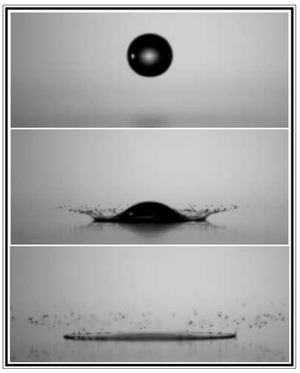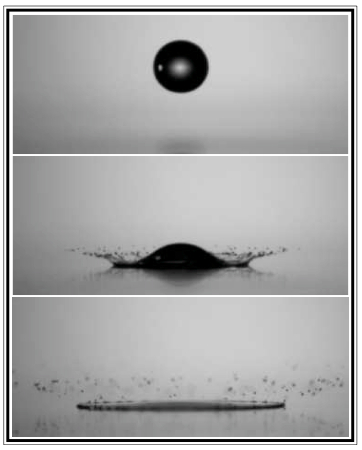What Makes a Droplet Splash?
When a liquid drop hits a solid surface, like a raindrop hitting pavement, it may flatten and spread smoothly, or it may produce a ragged-edged splash. But researchers don’t know which factors determine the result. Now a team in Spain says that the gas surrounding the droplet appears to be crucial to whether it splashes or not. They performed experiments with a range of liquids and worked out an equation that predicts the minimum velocity for a droplet to splash, depending on its size and the properties of the surrounding atmosphere. The results may lead to better understanding of systems such as ink jets and dispersal of pesticides and plant infections.
Industrial problems such as inkjet printing and coating of surfaces require a deep understanding of the impact of drops on solids. For example, researchers would like to know whether or not such impacts will produce a splash. It’s been long known that faster-moving drops fragment more readily than slower-moving ones and that other important factors include the drop size, liquid viscosity, and strength of the surface tension.
But Guillaume Riboux and José Manuel Gordillo of the University of Seville in Spain argue that these aspects of the problem haven’t been properly assembled before. Gordillo says that through a combination of experiment and theoretical analysis they have been able to “put all the pieces of a very complex puzzle together,” including the ambient gas properties, which haven’t been properly accounted for previously.
Using high-speed cameras, Riboux and Gordillo filmed droplets of eight different liquids, varying in density, surface tension, and viscosity, as they fell onto a solid surface at various speeds. They saw that, on impact, the liquid begins to spread out laterally over the surface in a sheet just a few tens of micrometers thick.
The next step depends on the specific liquid-surface interaction. For liquids that would ordinarily “bead up” rather than spread out on a surface, a thin layer of air intervenes below the spreading edge of the liquid sheet, so the liquid lifts off of the surface. Then, as the sheet rapidly advances it experiences aerodynamic lift, like an airplane wing.
In some cases this rise is only temporary: the sheet touches down again and spreads smoothly, with no splash. But in other cases the sheet continues to rise higher. Surface tension then creates a well-known instability in the edge of the sheet, which generates corrugations that grow to create a ragged splash and eject tiny drops. This is essentially the same instability that causes a thin stream of water from a faucet to fragment into drops.
The ambient air determines whether there is a sustained takeoff, the team found. Classically, if it worked like an airplane wing, the lift force would depend on the air density and the speed of the sheet. But the researchers found that, at these tiny scales, two other factors come into play: the viscosity of the gas and the so-called mean free path of the gas molecules—how far they travel, on average, before colliding with another molecule. This distance, which is around 65 nanometers for ambient air, determines the velocity of the gas flow very close to the solid surface, which in turn affects the upward force on the underside of the liquid sheet. The effect of the mean free path is usually negligible, but in the microscopically tiny gap between the liquid sheet and the solid surface, it becomes appreciable.
“This is a very nice piece of work,” says Bruno Andreotti of the University of Paris-Diderot. “It’s typical of the physics of complexity, in that the ideas are not individually new, but their combination to predict the splashing threshold is a demanding problem.” He says that the novelty “results from the proper introduction of the gas properties” and specifically the unexpected role of the mean free path of the gas.
A formula that predicts whether splashing will occur could help to make inkjet printing accurate and smooth, says Andreotti. Gordillo suggests the work could also help in reducing the spread of plant infections because it could allow researchers to calculate the minimum plant spacing needed to avoid bacterial transfer resulting from raindrop splashes. Knowledge of the drop-splashing threshold could also help criminal forensic scientists estimate the height from which blood drops fell, Riboux says.
–Philip Ball
Philip Ball is a freelance science writer in London. His latest book is How Life Works (Picador, 2024).





